Analyzing Customer Engagement via Social Media: A Sainsbury's Project
VerifiedAdded on 2020/12/09
|24
|4910
|149
Project
AI Summary
This project investigates the advantages of online customer engagement through social media, focusing on Sainsbury's as a case study. It begins with an introduction to the competitive landscape and the role of websites in attracting customers. The research aims to explore the benefits of engaging customers online, with objectives including understanding the importance of website design, analyzing the benefits of interactive websites, recognizing the need for social media adoption, and recommending effective engagement strategies to increase sales. The project includes a project management plan covering cost, scope, time, quality, resources, and risk. The research methodology involves a qualitative approach, using an inductive approach and a descriptive research design. Data collection methods include primary and secondary research, sampling, and ethical considerations. The project also presents a Gantt chart showing the implementation of activities. The findings include a questionnaire and analysis of customer engagement strategies, providing insights into how Sainsbury's can leverage social media to improve customer relationships and drive sales. The project emphasizes the importance of customer engagement, loyalty, and satisfaction in the retail industry.

MANAGING A
SUCCESSFUL BUSINESS
PROJECT
SUCCESSFUL BUSINESS
PROJECT
Paraphrase This Document
Need a fresh take? Get an instant paraphrase of this document with our AI Paraphraser
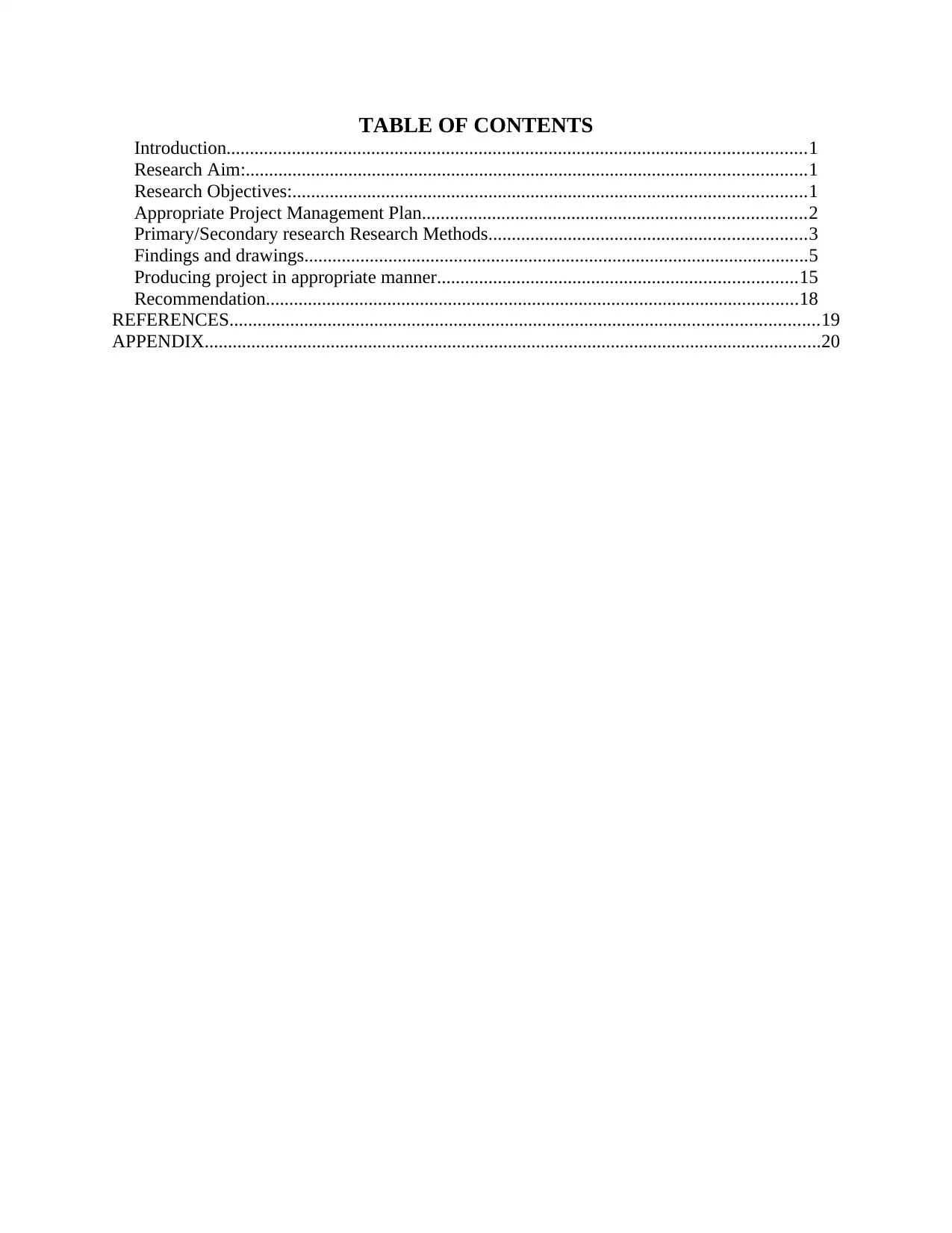
TABLE OF CONTENTS
Introduction............................................................................................................................1
Research Aim:........................................................................................................................1
Research Objectives:..............................................................................................................1
Appropriate Project Management Plan..................................................................................2
Primary/Secondary research Research Methods....................................................................3
Findings and drawings............................................................................................................5
Producing project in appropriate manner.............................................................................15
Recommendation..................................................................................................................18
REFERENCES..............................................................................................................................19
APPENDIX....................................................................................................................................20
Introduction............................................................................................................................1
Research Aim:........................................................................................................................1
Research Objectives:..............................................................................................................1
Appropriate Project Management Plan..................................................................................2
Primary/Secondary research Research Methods....................................................................3
Findings and drawings............................................................................................................5
Producing project in appropriate manner.............................................................................15
Recommendation..................................................................................................................18
REFERENCES..............................................................................................................................19
APPENDIX....................................................................................................................................20
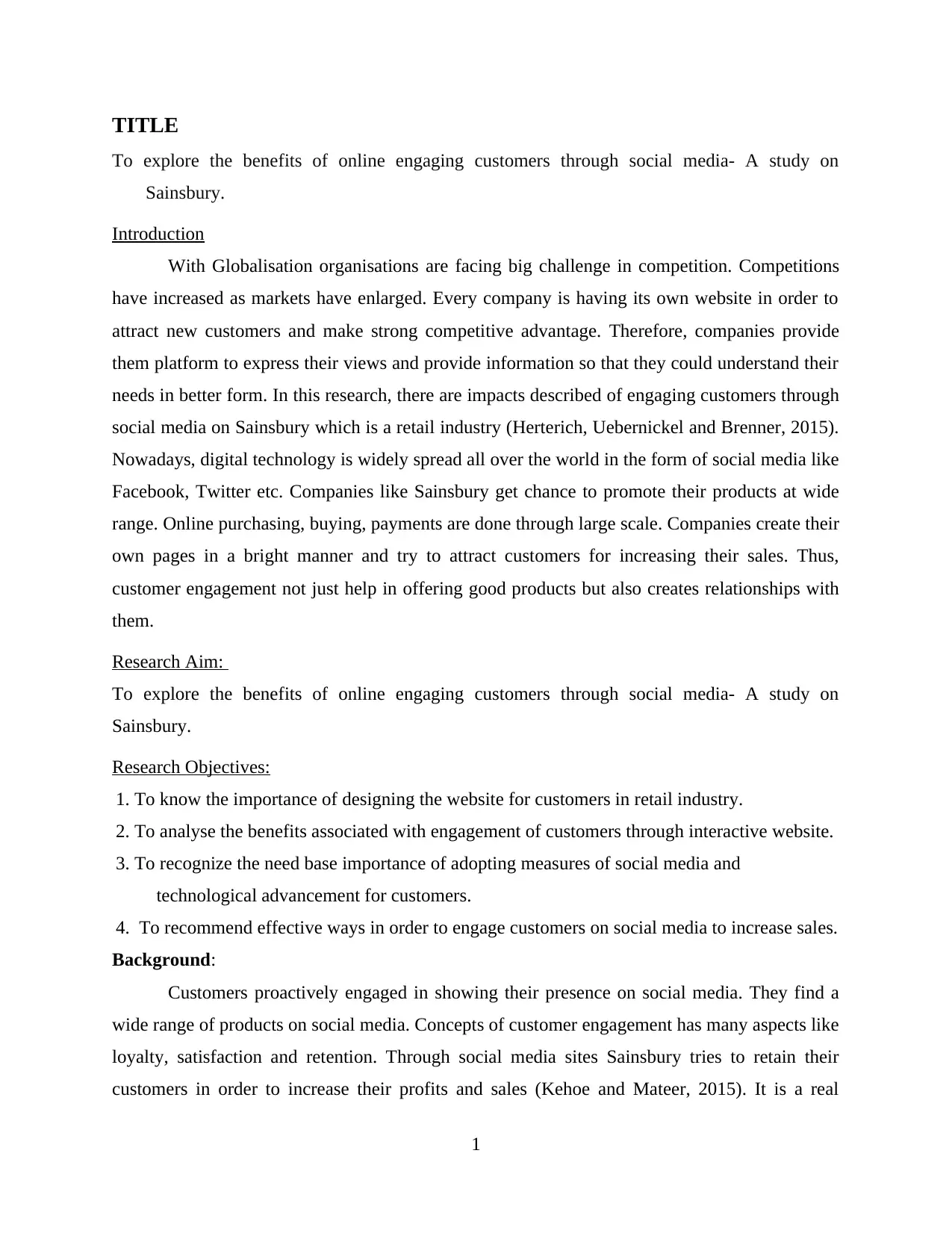
TITLE
To explore the benefits of online engaging customers through social media- A study on
Sainsbury.
Introduction
With Globalisation organisations are facing big challenge in competition. Competitions
have increased as markets have enlarged. Every company is having its own website in order to
attract new customers and make strong competitive advantage. Therefore, companies provide
them platform to express their views and provide information so that they could understand their
needs in better form. In this research, there are impacts described of engaging customers through
social media on Sainsbury which is a retail industry (Herterich, Uebernickel and Brenner, 2015).
Nowadays, digital technology is widely spread all over the world in the form of social media like
Facebook, Twitter etc. Companies like Sainsbury get chance to promote their products at wide
range. Online purchasing, buying, payments are done through large scale. Companies create their
own pages in a bright manner and try to attract customers for increasing their sales. Thus,
customer engagement not just help in offering good products but also creates relationships with
them.
Research Aim:
To explore the benefits of online engaging customers through social media- A study on
Sainsbury.
Research Objectives:
1. To know the importance of designing the website for customers in retail industry.
2. To analyse the benefits associated with engagement of customers through interactive website.
3. To recognize the need base importance of adopting measures of social media and
technological advancement for customers.
4. To recommend effective ways in order to engage customers on social media to increase sales.
Background:
Customers proactively engaged in showing their presence on social media. They find a
wide range of products on social media. Concepts of customer engagement has many aspects like
loyalty, satisfaction and retention. Through social media sites Sainsbury tries to retain their
customers in order to increase their profits and sales (Kehoe and Mateer, 2015). It is a real
1
To explore the benefits of online engaging customers through social media- A study on
Sainsbury.
Introduction
With Globalisation organisations are facing big challenge in competition. Competitions
have increased as markets have enlarged. Every company is having its own website in order to
attract new customers and make strong competitive advantage. Therefore, companies provide
them platform to express their views and provide information so that they could understand their
needs in better form. In this research, there are impacts described of engaging customers through
social media on Sainsbury which is a retail industry (Herterich, Uebernickel and Brenner, 2015).
Nowadays, digital technology is widely spread all over the world in the form of social media like
Facebook, Twitter etc. Companies like Sainsbury get chance to promote their products at wide
range. Online purchasing, buying, payments are done through large scale. Companies create their
own pages in a bright manner and try to attract customers for increasing their sales. Thus,
customer engagement not just help in offering good products but also creates relationships with
them.
Research Aim:
To explore the benefits of online engaging customers through social media- A study on
Sainsbury.
Research Objectives:
1. To know the importance of designing the website for customers in retail industry.
2. To analyse the benefits associated with engagement of customers through interactive website.
3. To recognize the need base importance of adopting measures of social media and
technological advancement for customers.
4. To recommend effective ways in order to engage customers on social media to increase sales.
Background:
Customers proactively engaged in showing their presence on social media. They find a
wide range of products on social media. Concepts of customer engagement has many aspects like
loyalty, satisfaction and retention. Through social media sites Sainsbury tries to retain their
customers in order to increase their profits and sales (Kehoe and Mateer, 2015). It is a real
1
⊘ This is a preview!⊘
Do you want full access?
Subscribe today to unlock all pages.

Trusted by 1+ million students worldwide
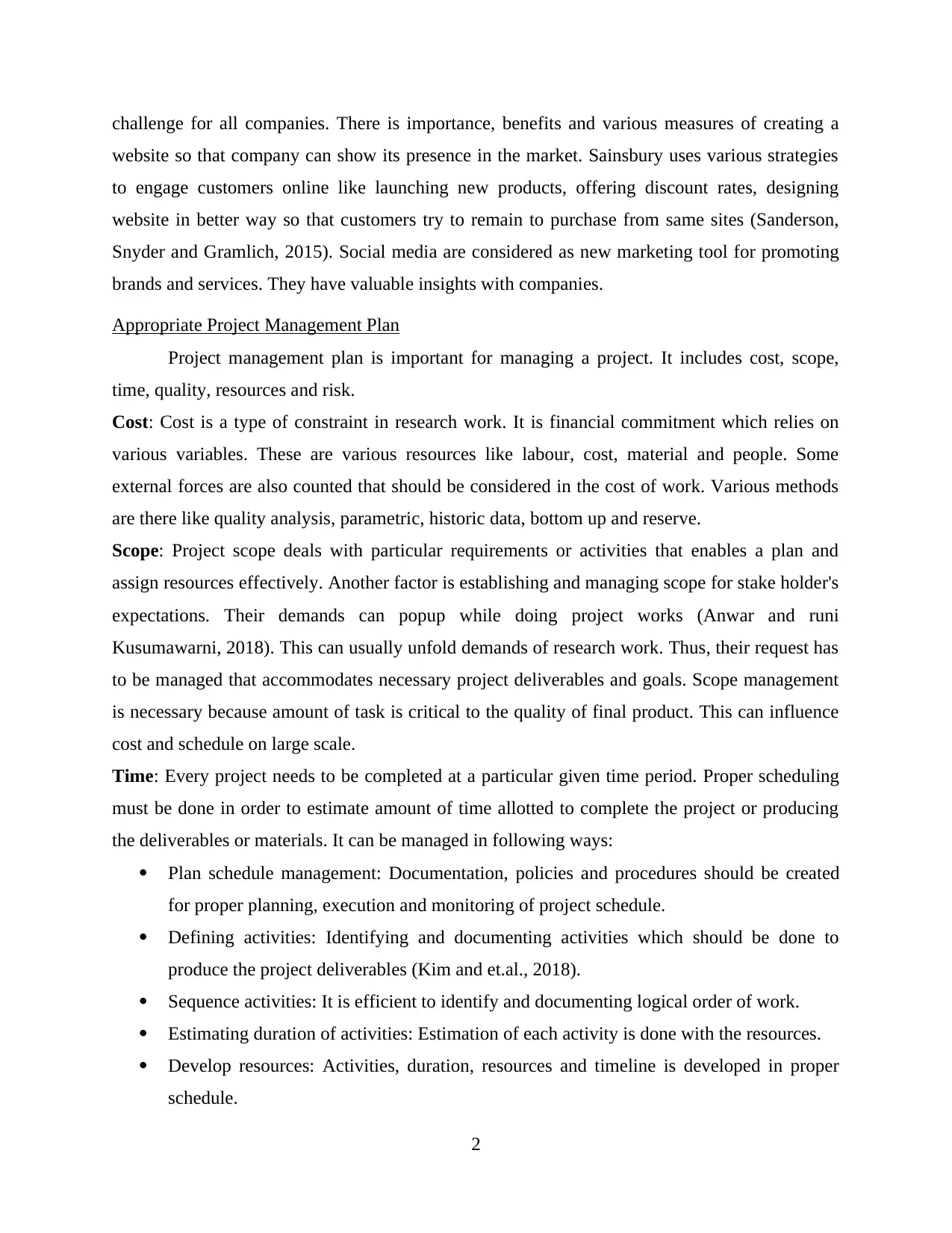
challenge for all companies. There is importance, benefits and various measures of creating a
website so that company can show its presence in the market. Sainsbury uses various strategies
to engage customers online like launching new products, offering discount rates, designing
website in better way so that customers try to remain to purchase from same sites (Sanderson,
Snyder and Gramlich, 2015). Social media are considered as new marketing tool for promoting
brands and services. They have valuable insights with companies.
Appropriate Project Management Plan
Project management plan is important for managing a project. It includes cost, scope,
time, quality, resources and risk.
Cost: Cost is a type of constraint in research work. It is financial commitment which relies on
various variables. These are various resources like labour, cost, material and people. Some
external forces are also counted that should be considered in the cost of work. Various methods
are there like quality analysis, parametric, historic data, bottom up and reserve.
Scope: Project scope deals with particular requirements or activities that enables a plan and
assign resources effectively. Another factor is establishing and managing scope for stake holder's
expectations. Their demands can popup while doing project works (Anwar and runi
Kusumawarni, 2018). This can usually unfold demands of research work. Thus, their request has
to be managed that accommodates necessary project deliverables and goals. Scope management
is necessary because amount of task is critical to the quality of final product. This can influence
cost and schedule on large scale.
Time: Every project needs to be completed at a particular given time period. Proper scheduling
must be done in order to estimate amount of time allotted to complete the project or producing
the deliverables or materials. It can be managed in following ways:
Plan schedule management: Documentation, policies and procedures should be created
for proper planning, execution and monitoring of project schedule.
Defining activities: Identifying and documenting activities which should be done to
produce the project deliverables (Kim and et.al., 2018).
Sequence activities: It is efficient to identify and documenting logical order of work.
Estimating duration of activities: Estimation of each activity is done with the resources.
Develop resources: Activities, duration, resources and timeline is developed in proper
schedule.
2
website so that company can show its presence in the market. Sainsbury uses various strategies
to engage customers online like launching new products, offering discount rates, designing
website in better way so that customers try to remain to purchase from same sites (Sanderson,
Snyder and Gramlich, 2015). Social media are considered as new marketing tool for promoting
brands and services. They have valuable insights with companies.
Appropriate Project Management Plan
Project management plan is important for managing a project. It includes cost, scope,
time, quality, resources and risk.
Cost: Cost is a type of constraint in research work. It is financial commitment which relies on
various variables. These are various resources like labour, cost, material and people. Some
external forces are also counted that should be considered in the cost of work. Various methods
are there like quality analysis, parametric, historic data, bottom up and reserve.
Scope: Project scope deals with particular requirements or activities that enables a plan and
assign resources effectively. Another factor is establishing and managing scope for stake holder's
expectations. Their demands can popup while doing project works (Anwar and runi
Kusumawarni, 2018). This can usually unfold demands of research work. Thus, their request has
to be managed that accommodates necessary project deliverables and goals. Scope management
is necessary because amount of task is critical to the quality of final product. This can influence
cost and schedule on large scale.
Time: Every project needs to be completed at a particular given time period. Proper scheduling
must be done in order to estimate amount of time allotted to complete the project or producing
the deliverables or materials. It can be managed in following ways:
Plan schedule management: Documentation, policies and procedures should be created
for proper planning, execution and monitoring of project schedule.
Defining activities: Identifying and documenting activities which should be done to
produce the project deliverables (Kim and et.al., 2018).
Sequence activities: It is efficient to identify and documenting logical order of work.
Estimating duration of activities: Estimation of each activity is done with the resources.
Develop resources: Activities, duration, resources and timeline is developed in proper
schedule.
2
Paraphrase This Document
Need a fresh take? Get an instant paraphrase of this document with our AI Paraphraser
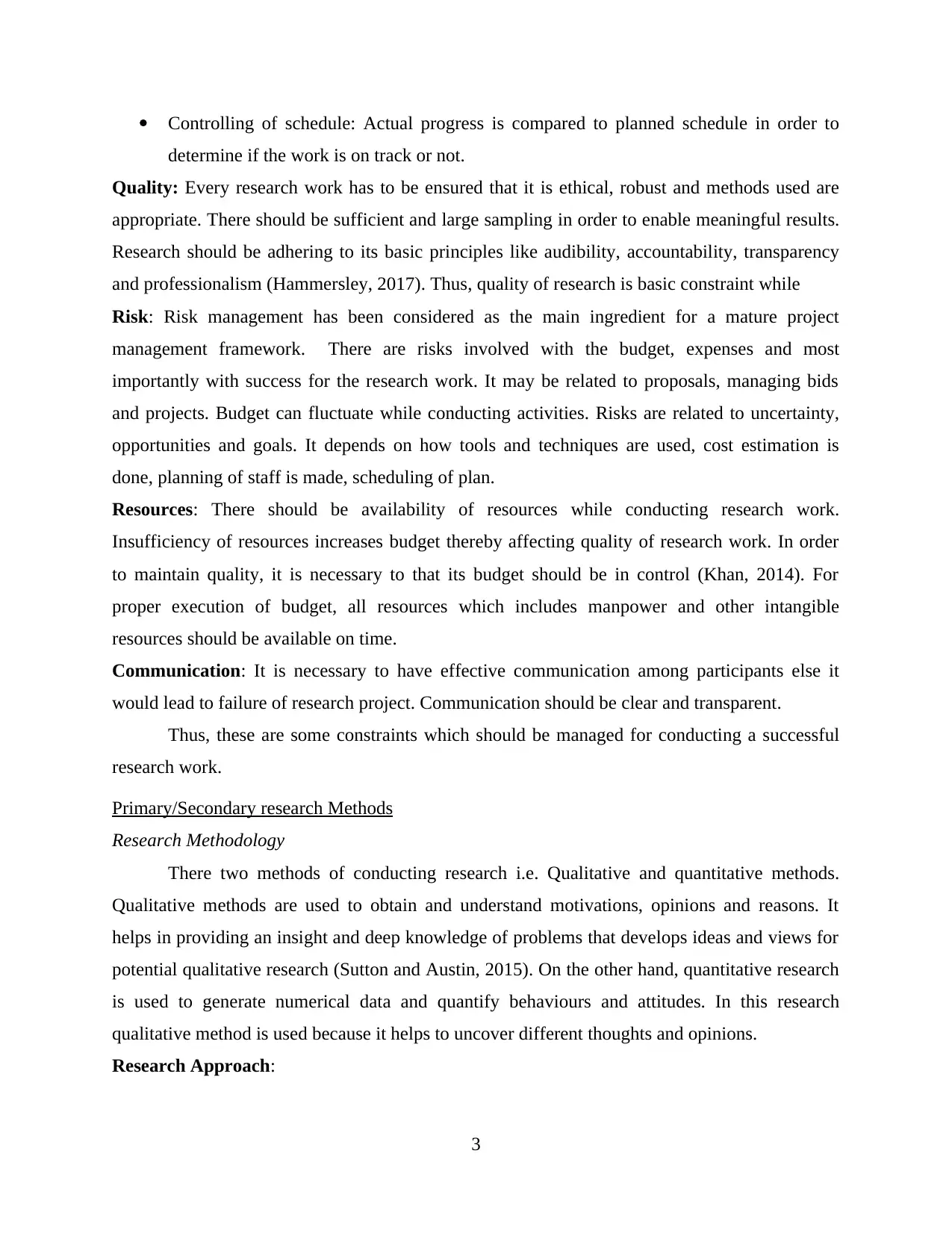
Controlling of schedule: Actual progress is compared to planned schedule in order to
determine if the work is on track or not.
Quality: Every research work has to be ensured that it is ethical, robust and methods used are
appropriate. There should be sufficient and large sampling in order to enable meaningful results.
Research should be adhering to its basic principles like audibility, accountability, transparency
and professionalism (Hammersley, 2017). Thus, quality of research is basic constraint while
Risk: Risk management has been considered as the main ingredient for a mature project
management framework. There are risks involved with the budget, expenses and most
importantly with success for the research work. It may be related to proposals, managing bids
and projects. Budget can fluctuate while conducting activities. Risks are related to uncertainty,
opportunities and goals. It depends on how tools and techniques are used, cost estimation is
done, planning of staff is made, scheduling of plan.
Resources: There should be availability of resources while conducting research work.
Insufficiency of resources increases budget thereby affecting quality of research work. In order
to maintain quality, it is necessary to that its budget should be in control (Khan, 2014). For
proper execution of budget, all resources which includes manpower and other intangible
resources should be available on time.
Communication: It is necessary to have effective communication among participants else it
would lead to failure of research project. Communication should be clear and transparent.
Thus, these are some constraints which should be managed for conducting a successful
research work.
Primary/Secondary research Methods
Research Methodology
There two methods of conducting research i.e. Qualitative and quantitative methods.
Qualitative methods are used to obtain and understand motivations, opinions and reasons. It
helps in providing an insight and deep knowledge of problems that develops ideas and views for
potential qualitative research (Sutton and Austin, 2015). On the other hand, quantitative research
is used to generate numerical data and quantify behaviours and attitudes. In this research
qualitative method is used because it helps to uncover different thoughts and opinions.
Research Approach:
3
determine if the work is on track or not.
Quality: Every research work has to be ensured that it is ethical, robust and methods used are
appropriate. There should be sufficient and large sampling in order to enable meaningful results.
Research should be adhering to its basic principles like audibility, accountability, transparency
and professionalism (Hammersley, 2017). Thus, quality of research is basic constraint while
Risk: Risk management has been considered as the main ingredient for a mature project
management framework. There are risks involved with the budget, expenses and most
importantly with success for the research work. It may be related to proposals, managing bids
and projects. Budget can fluctuate while conducting activities. Risks are related to uncertainty,
opportunities and goals. It depends on how tools and techniques are used, cost estimation is
done, planning of staff is made, scheduling of plan.
Resources: There should be availability of resources while conducting research work.
Insufficiency of resources increases budget thereby affecting quality of research work. In order
to maintain quality, it is necessary to that its budget should be in control (Khan, 2014). For
proper execution of budget, all resources which includes manpower and other intangible
resources should be available on time.
Communication: It is necessary to have effective communication among participants else it
would lead to failure of research project. Communication should be clear and transparent.
Thus, these are some constraints which should be managed for conducting a successful
research work.
Primary/Secondary research Methods
Research Methodology
There two methods of conducting research i.e. Qualitative and quantitative methods.
Qualitative methods are used to obtain and understand motivations, opinions and reasons. It
helps in providing an insight and deep knowledge of problems that develops ideas and views for
potential qualitative research (Sutton and Austin, 2015). On the other hand, quantitative research
is used to generate numerical data and quantify behaviours and attitudes. In this research
qualitative method is used because it helps to uncover different thoughts and opinions.
Research Approach:
3
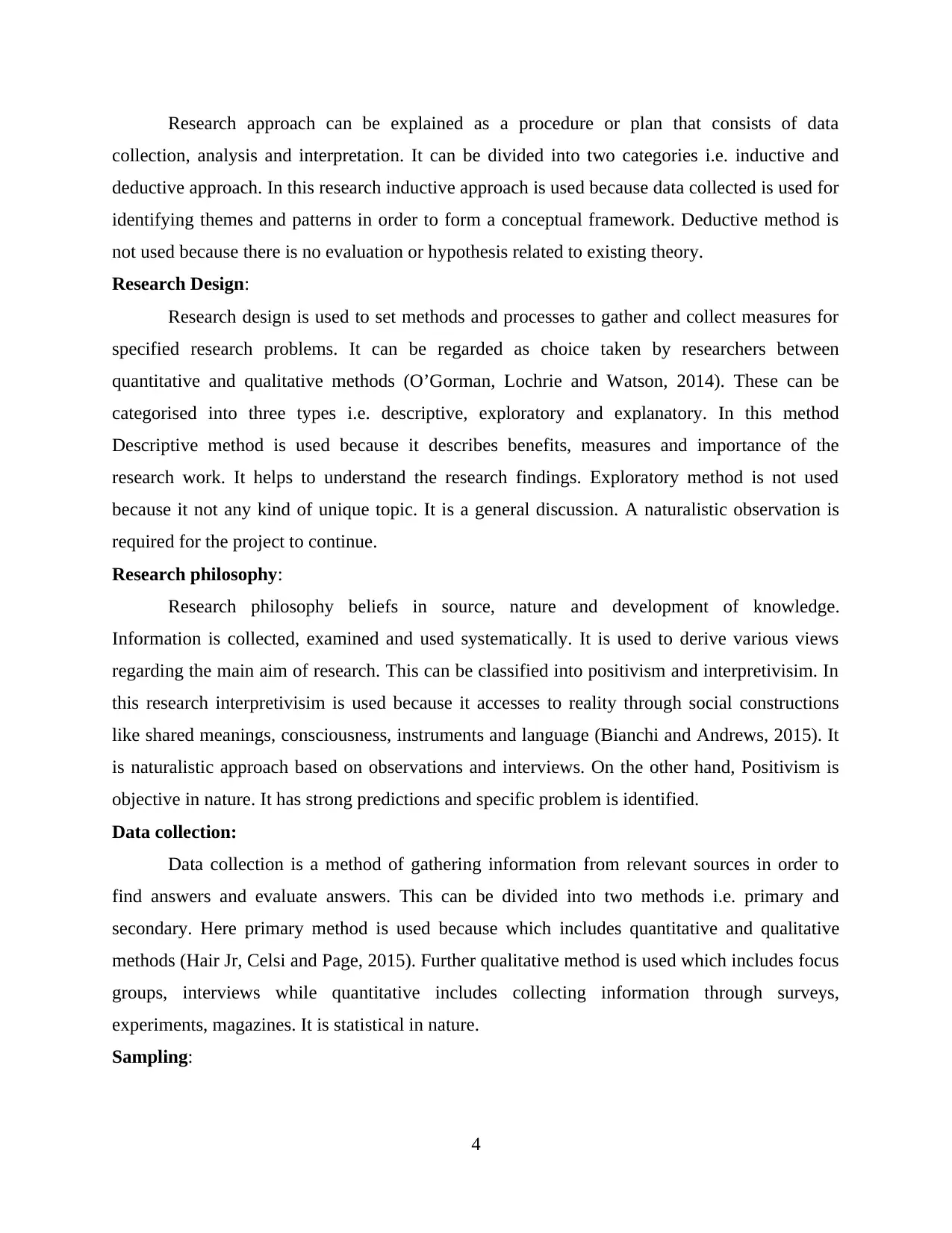
Research approach can be explained as a procedure or plan that consists of data
collection, analysis and interpretation. It can be divided into two categories i.e. inductive and
deductive approach. In this research inductive approach is used because data collected is used for
identifying themes and patterns in order to form a conceptual framework. Deductive method is
not used because there is no evaluation or hypothesis related to existing theory.
Research Design:
Research design is used to set methods and processes to gather and collect measures for
specified research problems. It can be regarded as choice taken by researchers between
quantitative and qualitative methods (O’Gorman, Lochrie and Watson, 2014). These can be
categorised into three types i.e. descriptive, exploratory and explanatory. In this method
Descriptive method is used because it describes benefits, measures and importance of the
research work. It helps to understand the research findings. Exploratory method is not used
because it not any kind of unique topic. It is a general discussion. A naturalistic observation is
required for the project to continue.
Research philosophy:
Research philosophy beliefs in source, nature and development of knowledge.
Information is collected, examined and used systematically. It is used to derive various views
regarding the main aim of research. This can be classified into positivism and interpretivisim. In
this research interpretivisim is used because it accesses to reality through social constructions
like shared meanings, consciousness, instruments and language (Bianchi and Andrews, 2015). It
is naturalistic approach based on observations and interviews. On the other hand, Positivism is
objective in nature. It has strong predictions and specific problem is identified.
Data collection:
Data collection is a method of gathering information from relevant sources in order to
find answers and evaluate answers. This can be divided into two methods i.e. primary and
secondary. Here primary method is used because which includes quantitative and qualitative
methods (Hair Jr, Celsi and Page, 2015). Further qualitative method is used which includes focus
groups, interviews while quantitative includes collecting information through surveys,
experiments, magazines. It is statistical in nature.
Sampling:
4
collection, analysis and interpretation. It can be divided into two categories i.e. inductive and
deductive approach. In this research inductive approach is used because data collected is used for
identifying themes and patterns in order to form a conceptual framework. Deductive method is
not used because there is no evaluation or hypothesis related to existing theory.
Research Design:
Research design is used to set methods and processes to gather and collect measures for
specified research problems. It can be regarded as choice taken by researchers between
quantitative and qualitative methods (O’Gorman, Lochrie and Watson, 2014). These can be
categorised into three types i.e. descriptive, exploratory and explanatory. In this method
Descriptive method is used because it describes benefits, measures and importance of the
research work. It helps to understand the research findings. Exploratory method is not used
because it not any kind of unique topic. It is a general discussion. A naturalistic observation is
required for the project to continue.
Research philosophy:
Research philosophy beliefs in source, nature and development of knowledge.
Information is collected, examined and used systematically. It is used to derive various views
regarding the main aim of research. This can be classified into positivism and interpretivisim. In
this research interpretivisim is used because it accesses to reality through social constructions
like shared meanings, consciousness, instruments and language (Bianchi and Andrews, 2015). It
is naturalistic approach based on observations and interviews. On the other hand, Positivism is
objective in nature. It has strong predictions and specific problem is identified.
Data collection:
Data collection is a method of gathering information from relevant sources in order to
find answers and evaluate answers. This can be divided into two methods i.e. primary and
secondary. Here primary method is used because which includes quantitative and qualitative
methods (Hair Jr, Celsi and Page, 2015). Further qualitative method is used which includes focus
groups, interviews while quantitative includes collecting information through surveys,
experiments, magazines. It is statistical in nature.
Sampling:
4
⊘ This is a preview!⊘
Do you want full access?
Subscribe today to unlock all pages.

Trusted by 1+ million students worldwide
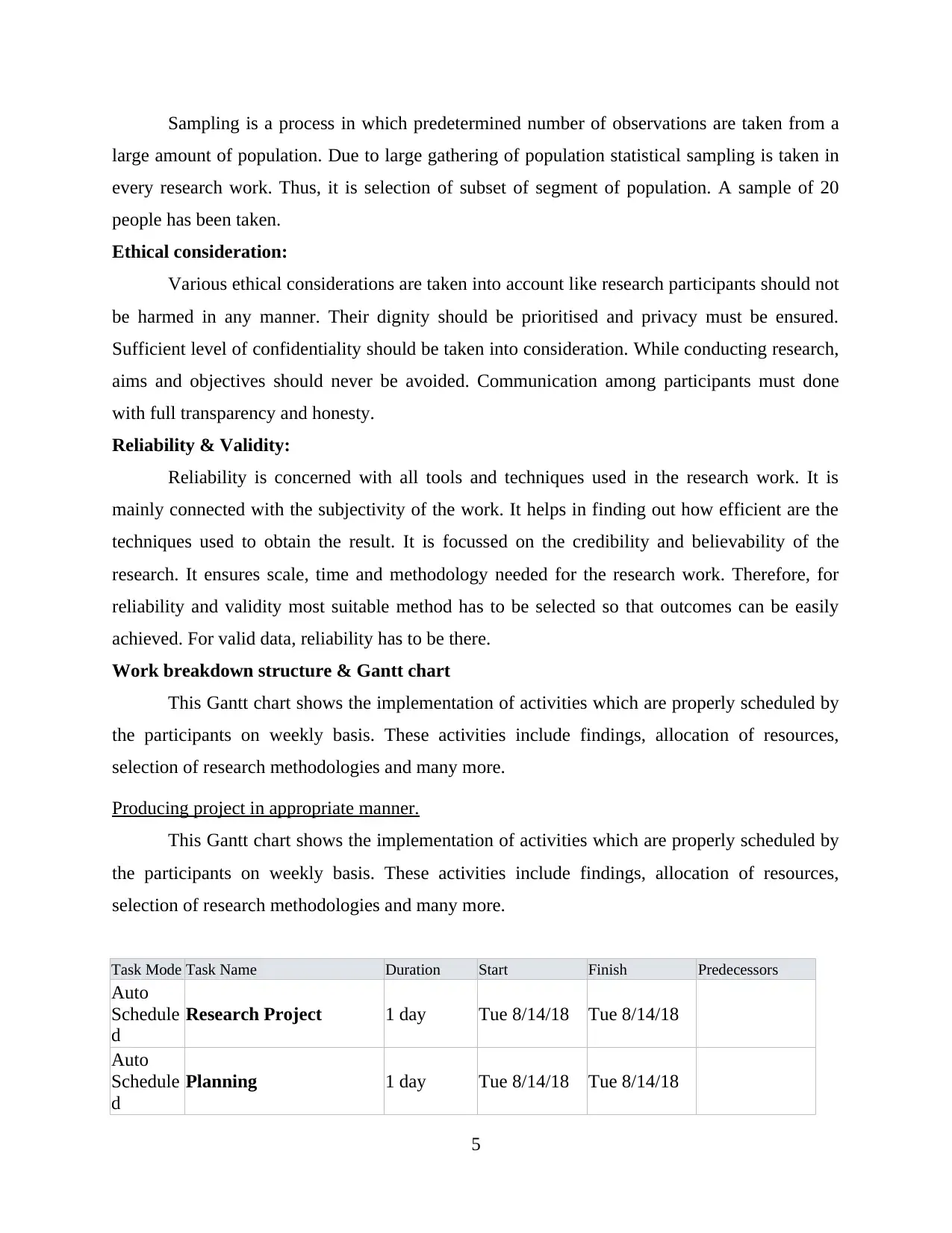
Sampling is a process in which predetermined number of observations are taken from a
large amount of population. Due to large gathering of population statistical sampling is taken in
every research work. Thus, it is selection of subset of segment of population. A sample of 20
people has been taken.
Ethical consideration:
Various ethical considerations are taken into account like research participants should not
be harmed in any manner. Their dignity should be prioritised and privacy must be ensured.
Sufficient level of confidentiality should be taken into consideration. While conducting research,
aims and objectives should never be avoided. Communication among participants must done
with full transparency and honesty.
Reliability & Validity:
Reliability is concerned with all tools and techniques used in the research work. It is
mainly connected with the subjectivity of the work. It helps in finding out how efficient are the
techniques used to obtain the result. It is focussed on the credibility and believability of the
research. It ensures scale, time and methodology needed for the research work. Therefore, for
reliability and validity most suitable method has to be selected so that outcomes can be easily
achieved. For valid data, reliability has to be there.
Work breakdown structure & Gantt chart
This Gantt chart shows the implementation of activities which are properly scheduled by
the participants on weekly basis. These activities include findings, allocation of resources,
selection of research methodologies and many more.
Producing project in appropriate manner.
This Gantt chart shows the implementation of activities which are properly scheduled by
the participants on weekly basis. These activities include findings, allocation of resources,
selection of research methodologies and many more.
Task Mode Task Name Duration Start Finish Predecessors
Auto
Schedule
d
Research Project 1 day Tue 8/14/18 Tue 8/14/18
Auto
Schedule
d
Planning 1 day Tue 8/14/18 Tue 8/14/18
5
large amount of population. Due to large gathering of population statistical sampling is taken in
every research work. Thus, it is selection of subset of segment of population. A sample of 20
people has been taken.
Ethical consideration:
Various ethical considerations are taken into account like research participants should not
be harmed in any manner. Their dignity should be prioritised and privacy must be ensured.
Sufficient level of confidentiality should be taken into consideration. While conducting research,
aims and objectives should never be avoided. Communication among participants must done
with full transparency and honesty.
Reliability & Validity:
Reliability is concerned with all tools and techniques used in the research work. It is
mainly connected with the subjectivity of the work. It helps in finding out how efficient are the
techniques used to obtain the result. It is focussed on the credibility and believability of the
research. It ensures scale, time and methodology needed for the research work. Therefore, for
reliability and validity most suitable method has to be selected so that outcomes can be easily
achieved. For valid data, reliability has to be there.
Work breakdown structure & Gantt chart
This Gantt chart shows the implementation of activities which are properly scheduled by
the participants on weekly basis. These activities include findings, allocation of resources,
selection of research methodologies and many more.
Producing project in appropriate manner.
This Gantt chart shows the implementation of activities which are properly scheduled by
the participants on weekly basis. These activities include findings, allocation of resources,
selection of research methodologies and many more.
Task Mode Task Name Duration Start Finish Predecessors
Auto
Schedule
d
Research Project 1 day Tue 8/14/18 Tue 8/14/18
Auto
Schedule
d
Planning 1 day Tue 8/14/18 Tue 8/14/18
5
Paraphrase This Document
Need a fresh take? Get an instant paraphrase of this document with our AI Paraphraser
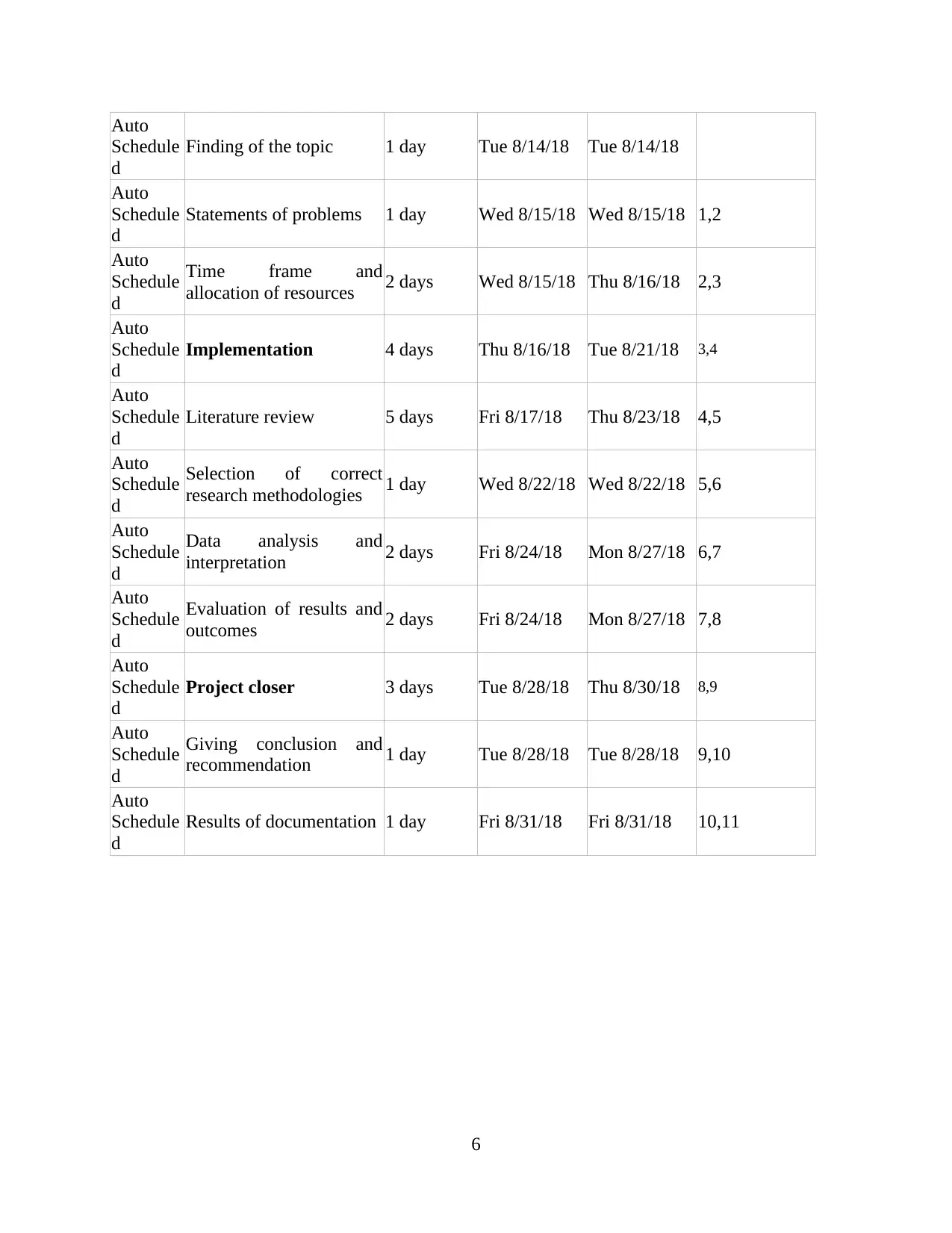
Auto
Schedule
d
Finding of the topic 1 day Tue 8/14/18 Tue 8/14/18
Auto
Schedule
d
Statements of problems 1 day Wed 8/15/18 Wed 8/15/18 1,2
Auto
Schedule
d
Time frame and
allocation of resources 2 days Wed 8/15/18 Thu 8/16/18 2,3
Auto
Schedule
d
Implementation 4 days Thu 8/16/18 Tue 8/21/18 3,4
Auto
Schedule
d
Literature review 5 days Fri 8/17/18 Thu 8/23/18 4,5
Auto
Schedule
d
Selection of correct
research methodologies 1 day Wed 8/22/18 Wed 8/22/18 5,6
Auto
Schedule
d
Data analysis and
interpretation 2 days Fri 8/24/18 Mon 8/27/18 6,7
Auto
Schedule
d
Evaluation of results and
outcomes 2 days Fri 8/24/18 Mon 8/27/18 7,8
Auto
Schedule
d
Project closer 3 days Tue 8/28/18 Thu 8/30/18 8,9
Auto
Schedule
d
Giving conclusion and
recommendation 1 day Tue 8/28/18 Tue 8/28/18 9,10
Auto
Schedule
d
Results of documentation 1 day Fri 8/31/18 Fri 8/31/18 10,11
6
Schedule
d
Finding of the topic 1 day Tue 8/14/18 Tue 8/14/18
Auto
Schedule
d
Statements of problems 1 day Wed 8/15/18 Wed 8/15/18 1,2
Auto
Schedule
d
Time frame and
allocation of resources 2 days Wed 8/15/18 Thu 8/16/18 2,3
Auto
Schedule
d
Implementation 4 days Thu 8/16/18 Tue 8/21/18 3,4
Auto
Schedule
d
Literature review 5 days Fri 8/17/18 Thu 8/23/18 4,5
Auto
Schedule
d
Selection of correct
research methodologies 1 day Wed 8/22/18 Wed 8/22/18 5,6
Auto
Schedule
d
Data analysis and
interpretation 2 days Fri 8/24/18 Mon 8/27/18 6,7
Auto
Schedule
d
Evaluation of results and
outcomes 2 days Fri 8/24/18 Mon 8/27/18 7,8
Auto
Schedule
d
Project closer 3 days Tue 8/28/18 Thu 8/30/18 8,9
Auto
Schedule
d
Giving conclusion and
recommendation 1 day Tue 8/28/18 Tue 8/28/18 9,10
Auto
Schedule
d
Results of documentation 1 day Fri 8/31/18 Fri 8/31/18 10,11
6
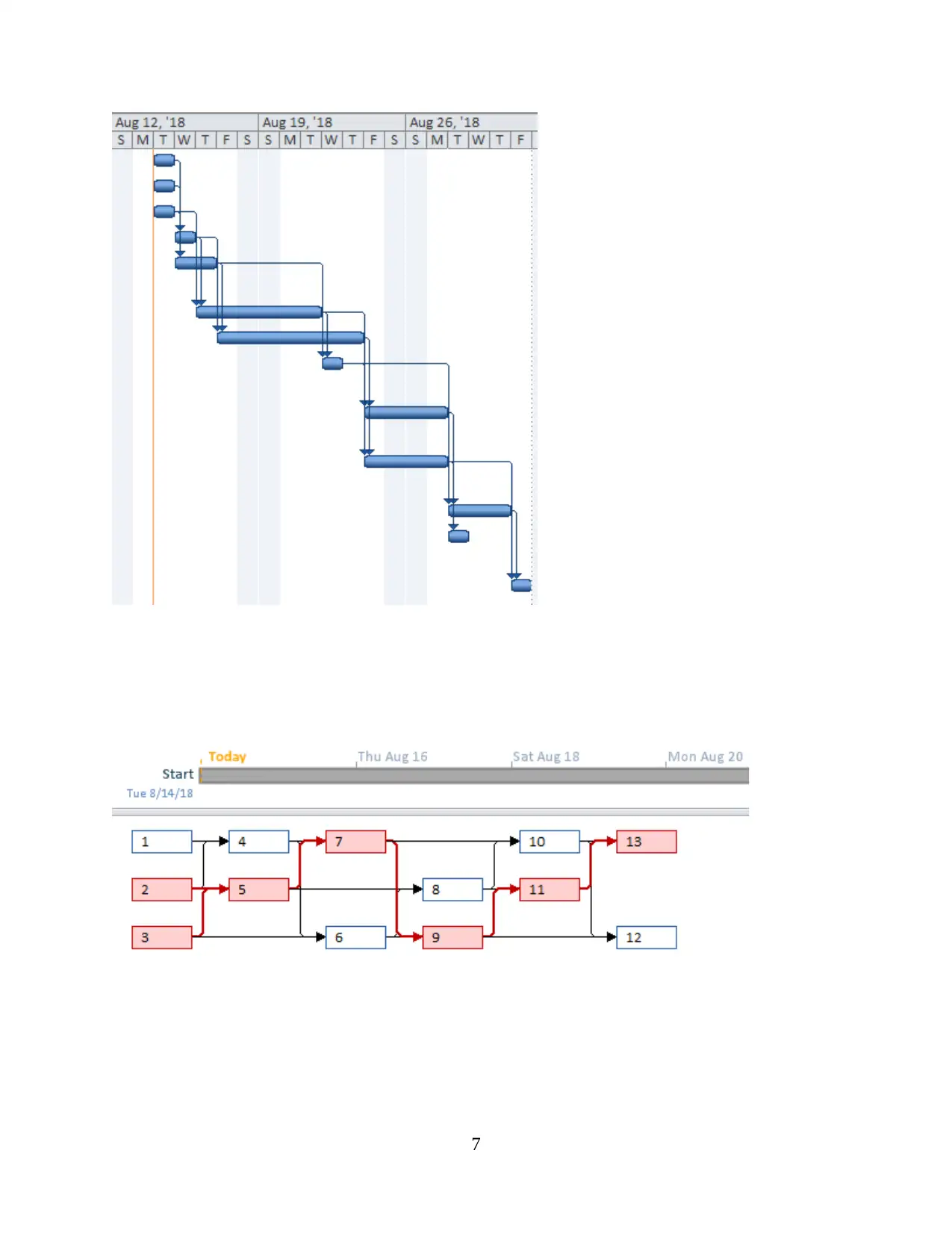
7
⊘ This is a preview!⊘
Do you want full access?
Subscribe today to unlock all pages.

Trusted by 1+ million students worldwide
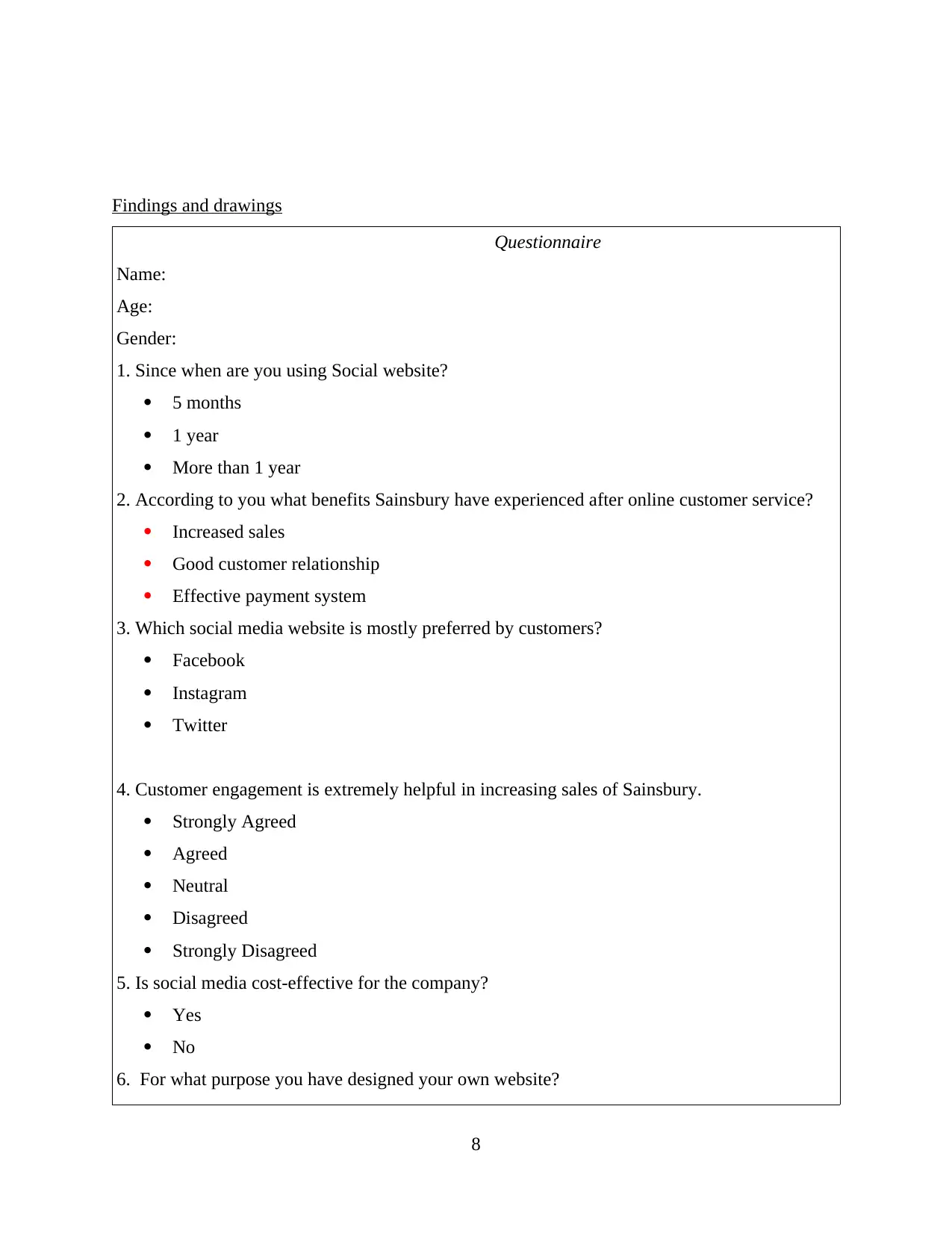
Findings and drawings
Questionnaire
Name:
Age:
Gender:
1. Since when are you using Social website?
5 months
1 year
More than 1 year
2. According to you what benefits Sainsbury have experienced after online customer service?
Increased sales
Good customer relationship
Effective payment system
3. Which social media website is mostly preferred by customers?
Facebook
Instagram
Twitter
4. Customer engagement is extremely helpful in increasing sales of Sainsbury.
Strongly Agreed
Agreed
Neutral
Disagreed
Strongly Disagreed
5. Is social media cost-effective for the company?
Yes
No
6. For what purpose you have designed your own website?
8
Questionnaire
Name:
Age:
Gender:
1. Since when are you using Social website?
5 months
1 year
More than 1 year
2. According to you what benefits Sainsbury have experienced after online customer service?
Increased sales
Good customer relationship
Effective payment system
3. Which social media website is mostly preferred by customers?
4. Customer engagement is extremely helpful in increasing sales of Sainsbury.
Strongly Agreed
Agreed
Neutral
Disagreed
Strongly Disagreed
5. Is social media cost-effective for the company?
Yes
No
6. For what purpose you have designed your own website?
8
Paraphrase This Document
Need a fresh take? Get an instant paraphrase of this document with our AI Paraphraser
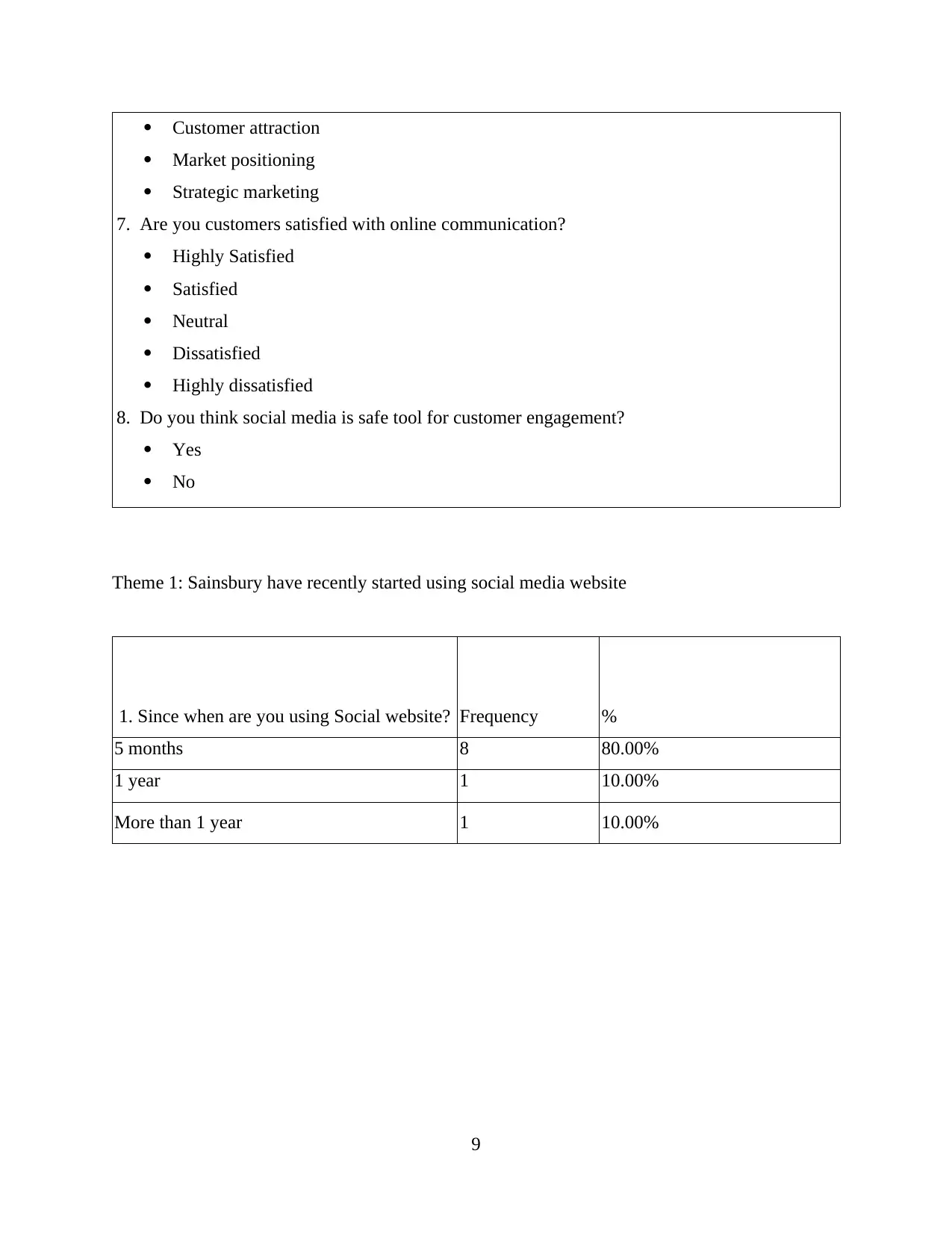
Customer attraction
Market positioning
Strategic marketing
7. Are you customers satisfied with online communication?
Highly Satisfied
Satisfied
Neutral
Dissatisfied
Highly dissatisfied
8. Do you think social media is safe tool for customer engagement?
Yes
No
Theme 1: Sainsbury have recently started using social media website
1. Since when are you using Social website? Frequency %
5 months 8 80.00%
1 year 1 10.00%
More than 1 year 1 10.00%
9
Market positioning
Strategic marketing
7. Are you customers satisfied with online communication?
Highly Satisfied
Satisfied
Neutral
Dissatisfied
Highly dissatisfied
8. Do you think social media is safe tool for customer engagement?
Yes
No
Theme 1: Sainsbury have recently started using social media website
1. Since when are you using Social website? Frequency %
5 months 8 80.00%
1 year 1 10.00%
More than 1 year 1 10.00%
9
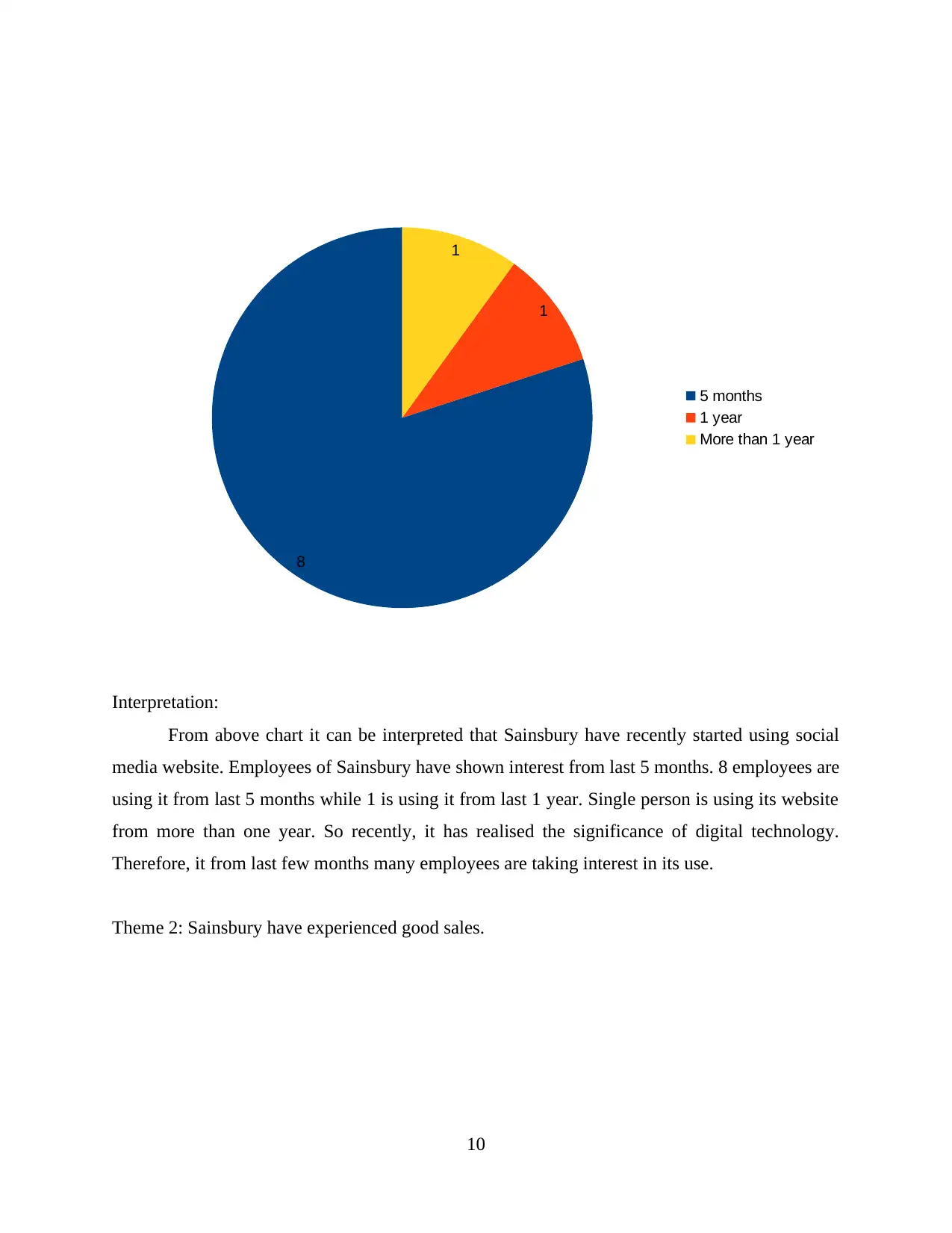
Interpretation:
From above chart it can be interpreted that Sainsbury have recently started using social
media website. Employees of Sainsbury have shown interest from last 5 months. 8 employees are
using it from last 5 months while 1 is using it from last 1 year. Single person is using its website
from more than one year. So recently, it has realised the significance of digital technology.
Therefore, it from last few months many employees are taking interest in its use.
Theme 2: Sainsbury have experienced good sales.
10
8
1
1
5 months
1 year
More than 1 year
From above chart it can be interpreted that Sainsbury have recently started using social
media website. Employees of Sainsbury have shown interest from last 5 months. 8 employees are
using it from last 5 months while 1 is using it from last 1 year. Single person is using its website
from more than one year. So recently, it has realised the significance of digital technology.
Therefore, it from last few months many employees are taking interest in its use.
Theme 2: Sainsbury have experienced good sales.
10
8
1
1
5 months
1 year
More than 1 year
⊘ This is a preview!⊘
Do you want full access?
Subscribe today to unlock all pages.

Trusted by 1+ million students worldwide
1 out of 24
Related Documents
Your All-in-One AI-Powered Toolkit for Academic Success.
+13062052269
info@desklib.com
Available 24*7 on WhatsApp / Email
![[object Object]](/_next/static/media/star-bottom.7253800d.svg)
Unlock your academic potential
Copyright © 2020–2025 A2Z Services. All Rights Reserved. Developed and managed by ZUCOL.





